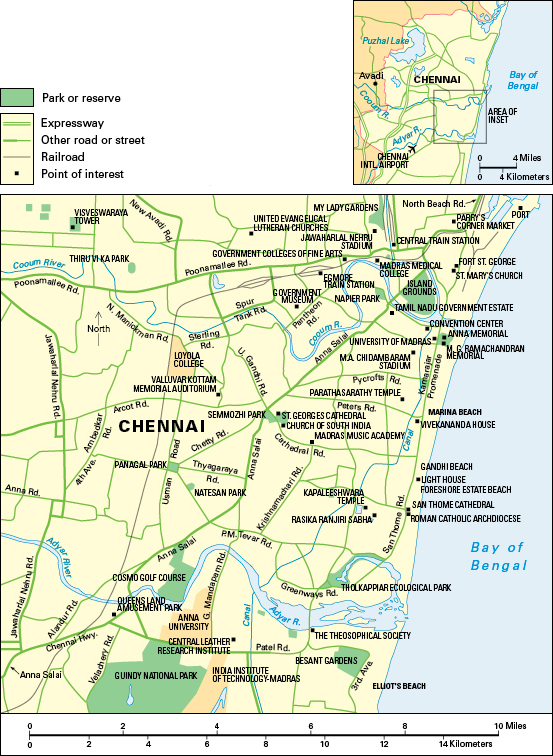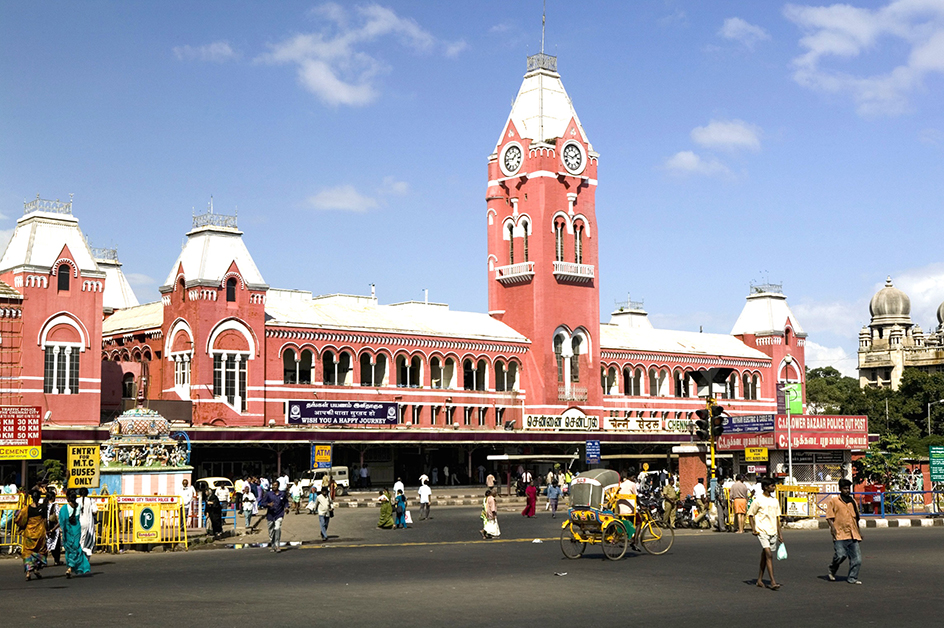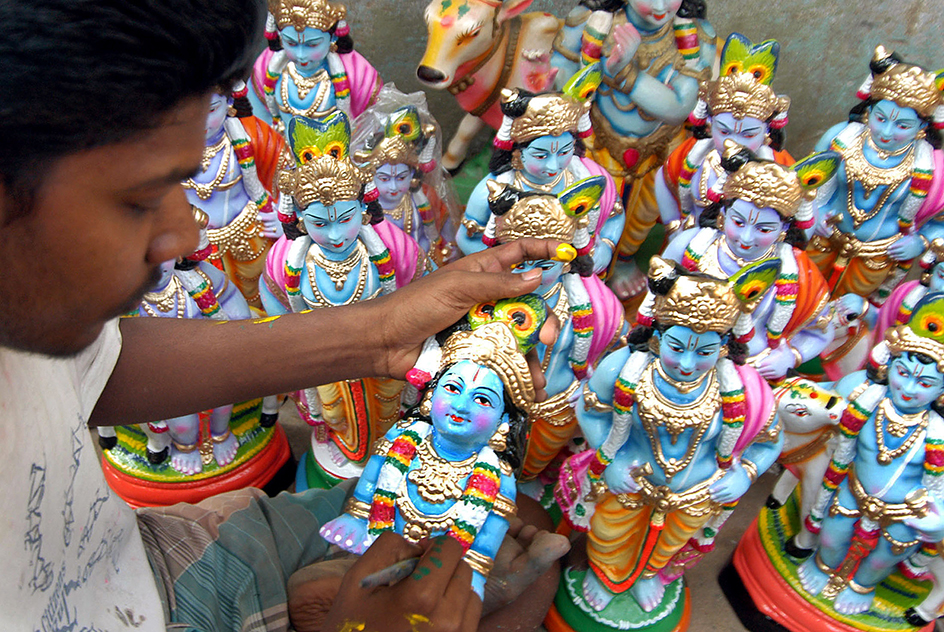Chennai, << cheh NY >> (pop. 4,646,732; met. area pop. 8,696,010), formerly called Madras, is India’s sixth largest city. Only Mumbai, Delhi, Bengaluru, Hyderabad, and Ahmadabad have more people. Chennai lies on India’s southeast coast.

Chennai is the capital of the state of Tamil Nadu. It is the state’s chief port and commercial city. Chennai sprawls over an area of more than 50 square miles (130 square kilometers). Despite its huge population, Chennai has an uncluttered and relaxed appearance.
The most obvious feature of Chennai is Marina beach. It runs from the harbor in the north to San Thome Cathedral in the south. The beach stretches for about 8 miles (13 kilometers), and is claimed to be the second-longest beach in the world. Elliot’s beach is a continuation of Marina beach. It lies on the far side of the Adyar River which flows through the southern half of the city.
The older part of Chennai lies to the west of Fort St. George and the harbor, and to the north of Poonamallee High Road. In this sector stand the city’s two main railroad stations—Egmore, with lines leading southward, and Central, which links up with the national rail network. Both stations are surrounded by office blocks and crowded markets. The markets include Parry’s Corner beside the High Court, and Burma Bazaar next to the bus station.

The modern part of Chennai lies to the south. It is divided diagonally by its most important road, Anna Salai Road (known locally as Mount Road). The road runs from south to west from Fort St. George, and passes through the main area of hotels and shops. The suburb of Kodambakkam, home of the film industry, lies on the western outskirts of the city.
Buildings.
Chennai’s buildings include a number of large Hindu temples constructed in the elaborate Dravidian style of architecture. The Parathasarathy temple was founded by the Pallava dynasty in the A.D. 700’s. The Kapaleeshwara temple occupies a site that has been sacred since the A.D. 600’s.
The Valluvar Kottam memorial is a 4,000-seat auditorium, built from 3,000 massive blocks of white granite. These blocks are inscribed with 1,330 verses of the Thirukkural, a philosophical Tamil poem composed by the poet-saint Thiruvalluvar in the A.D. 100’s.
San Thome Cathedral, a Roman Catholic Church, was originally built by the Portuguese in 1504. The church later fell into decay and the present building, the third church constructed on the site, dates from 1893.
Fort St. George was built in 1653 by the British East India Company. Today, the buildings of the old fort house the state administrative offices, the legislative assembly, and a museum devoted to the history of the East India Company. A banqueting hall built in the Greek style is still used for civic functions.
St. Mary’s Church, the oldest Anglican church in Asia, dates from about 1680. The church was visited by a number of famous personalities linked with the East India Company. They included Elihu Yale, after whom the American university was named; Robert Clive, the British administrator who took India into the British Empire; and Arthur Wellesley, who later, as the Duke of Wellington, defeated Napoleon in the Battle of Waterloo.
People.
Most of the people in Chennai are Dravidians. Their ancestors originated in the Mediterranean area thousands of years ago.
Education and cultural life.
The University of Madras was founded by the British in 1857. Today, it is a leading research center for plant diseases, physics, and Indian philosophy.
The Madras Music Academy promotes traditional music of the Carnatic region. The Kalakshetra is a classical dance center. The Rasika Ranjiri Sabha is a dramatic academy. The entire city celebrates a music and dance festival in December and January each year. Chennai also has several theatres. The suburb of Kodambakkam has been called the Hollywood of southern India because of its large output of films. The studios also dub foreign films into local languages.
Religion and languages.
Most citizens of Chennai are Hindus and speak Tamil. But the city also has a large number of other religious groups including Christians, Muslims, and Parsees. Other important languages include English and Telugu.

The Hindu population observes the normal religious festivals of India throughout the year (see Hinduism ). In addition, there are three festivals specific to Chennai. In January there is a harvest festival called Pongali, which means new rice cooked. Two other festivals are especially associated with the Kapaleeshwarara temple in the Mylapore district. The temple’s large water tank is used to celebrate the Float Festival, which is held in January or February. Arupathumoovar, held in March, is an 11-day event in which 63 bronze images of the disciples of Shiva are removed from their places in the temple and carried in procession.
Christians are also well represented in Chennai. The city is the center of a Roman Catholic archdiocese (district under the control of an archbishop). The archdiocese was founded by the Portuguese in 1606. Chennai is also the headquarters of the Church of South India. This church was founded in 1947 to unite Anglicans with various other Protestant denominations. The United Evangelical Lutheran Churches in India, formed in 1975 to bring together nine separate sects, also have their headquarters in Chennai.
The Theosophical Society, founded in New York in 1875 by the philosopher Elena Blavatsky, transferred its headquarters to Madras in 1882. The society’s main building is a mansion built in 1766 by the English merchant John Huddlestone.
The local press reflects the variety of languages spoken in the city. There are four daily newspapers in Tamil and two in English. There are more than 20 locally produced monthly or weekly publications. Half of them are in Tamil. The rest are in English, Malayalam, Marathi, Odia, and Telugu. There are also book publishers and radio and television stations.
Economy.
The manufacture of cotton fabrics was an established local industry in Madras by the 1600’s. It still forms a major part of the local economy, and the skill of Chennai craftworkers has earned contracts from international fashion designers. The city houses the nation’s Central Leather Research Institute, and leather working is another traditional skill that continues to flourish. Modern enterprises include electrical engineering, motor vehicle assembly, an oil refinery, and the production of fertilizers and rubber.
Chennai exports cotton goods, iron ore, leather, and peanuts. It imports raw cotton, iron and steel, machinery, and wheat.
Service industries are also important to the local economy. The city houses the state’s government, many educational and research institutions, and the film industry of Kodambakkam. The local Chamber of Commerce and Industry is one of the oldest in India, dating from 1836. The local stock exchange was founded in 1937.
Transportation.
Chennai is one of India’s main ports. Chennai International Airport provides flights to other major Indian cities, and to Sri Lanka and the Andaman Islands. Chennai, with its two major railroad stations, is also the headquarters of India’s southern railroad zone.
Government.
As the capital of Tamil Nadu, Chennai is the home of the 234-member state legislature. The governor provides a link with the national government in New Delhi. The chief minister manages local affairs. The management of the day-to-day public services of the city rests with the Chennai Municipal Corporation.
History.
According to tradition, St. Thomas, one of the 12 apostles of Jesus Christ, landed on the west coast of India about A.D. 58 and made his way toward the east of the country. He is said to have preached and converted people to Christianity in the region where Chennai now stands, until he was martyred (killed for his religious beliefs) in 72. The place where this is supposed to have happened is now known as St. Thomas Mount, close to the international airport. The saint’s body is believed to have been buried in the village of Mylapore, now a Chennai suburb. According to legend, Nestorian Christians from Persia located the grave in the 1000’s and built a tomb and church on the site.
The Venetian merchant Marco Polo, in his account of his travels in Asia, confirmed the existence of that church. But by the time the Portuguese arrived there in the 1500’s, both village and church were virtually in ruins. The Portuguese built a new church in 1522, but this church also fell into disrepair and had to be pulled down.
The history of Chennai as a major city begins with the arrival of the British in 1601. At that time, they were trading for spices along the Coromandel coast. In 1611, the East India Company established its first factory (trading station) at Machilipatnam. But powerful Dutch rivals soon overshadowed this station and set up a fortified base at Pulicat. As a result, the British decided to move farther down the coast where spices and textiles were cheaper.
In 1639, the British rented a strip of land from the allied rajah of Chandragiri near the village of Madraspatnam. In February 1640, a small advance party began to build a secure base there. They completed the protecting walls on April 23, St. George’s Day, and from then on, the building was known as Fort St. George. It was completed in 1644. The British settlement around Fort St. George expanded rapidly, while to the north there developed an exclusively Indian area.
By 1652, Madras had become a presidency, with local control over its own affairs. In 1676, the village of Triplicane was leased from the sultan of Golconda. In 1688, King James II granted Madras a municipal charter, making it the first Indian town to receive such recognition. In 1693, Madras expanded still more with Elihu Yale’s lease of Egmore, Puraswalkam, and Tondiarpet. The municipal territory was enlarged again in 1703 and 1742. French forces occupied Madras from 1746 to 1748. After they were thrown out, the city continued to grow until 1774, when the East India Company chose to make Calcutta (now Kolkata) its main Indian base.
From then on, Madras, although outranked by Calcutta, continued to expand slowly.
In 1816, an Anglican cathedral was consecrated. Next to the cathedral, the Madras Horticultural Society laid out public gardens in 1835. Wealthy merchants built themselves splendid palaces, some of whose names, such as Leith Castle and Brodie Castle, declare their Scottish origin. After Indian independence in 1947, the city boundaries expanded rapidly.
See also Tamil Nadu .
